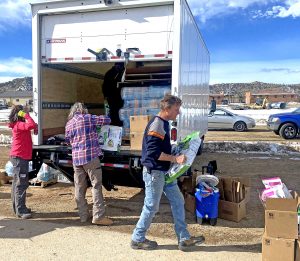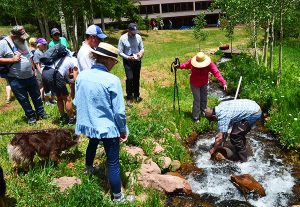by Edie Flanagin
LA VETA- The third public forum of the Transmission Line Coalition group met last Wednesday evening in La Veta and pitted six electric company representatives, including engineers and public affairs spokesmen, against about 75 vocal and concerned Huerfano citizens. The Southern Colorado (SoCo) transmission line proposal has received a lot of public scrutiny here in Huerfano County as well as in the San Luis Valley because it will cross over private property, be near homes, and adversely effect the view of many residents of the area. Part of the proposed route is along Highway 160, a designated scenic corridor.
The panel of three Tri-State employees and three Xcel employees used maps and graphs to explain the need for the proposed SoCo transmission line from the San Luis Valley across La Veta Pass to Walsenburg. The projected cost of the line is $180 million. Tri-State, the provider of electricity for 44 not-for-profit, member-owned rural cooperatives, will pay $75 million and Xcel, a for profit, publicly owned company, will put up $105 million for the project. According to the data provided, the cost of the power line will be spread out over about 2 million electric customers and will add only about 34 cents to a monthly bill. The panel also pointed out that the four counties affected by the line will get an economic boost through construction funds/personnel in the areas and through annual property tax income of approximately $2.5 million.
The first argument for a new power line, the representatives said, is to make a complete “loop system” to connect the San Luis Valley with the front range grid in Huerfano County. According to them, the loop will allow for greater reliability and redundancy to both areas. Using a map of Colorado showing the major power corridors, an Xcel spokesman showed how the major population centers are surrounded by the grid. If electricity is cut off for some reason on one side, the electrons can be rerouted to go around the other way, forming a redundant loop system. The map shows that Walsenburg and the San Luis Valley are “dead ends” because these two areas can only get their energy from one direction, (although there are three separate lines connecting the SLV and two connecting Walsenburg). They said there have been several “major” outages in the past as well as graphs showing the historic use of energy in the San Luis Valley. One graph showed the electric use in the San Luis Valley exceeds the 65 megawatt (MW) load capacity of the existing lines during the summer irrigation months. One Xcel energy manager, Kathy Worthington said “the system could fail any time during the summer and that we have been lucky a major failure hasn’t occurred.” She said that the potato farmers rely on electricity to keep their crops alive and refrigerated; without a reliable grid the whole crop could fail.
Another reason given for the line is that Tri-state and Xcel need to make connections to the excellent renewable energy areas in both the San Luis valley and the prairies east and south of Walsenburg. Colorado law has mandated that electric companies get 30% of their energy from renewables by 2020, therefore the electric providers are looking into ways to get the alternative energy onto the grid. The companies’ spokesmen at the meeting admitted the lines between Walsenburg and Pueblo are adequate for renewable energy projects now or in the foreseeable future. The old 115 KV and 230 KV lines running into and out of the San Luis Valley are the problem. They do not provide enough load potential for large amounts of electricity to be exported. The proposed Southern Colorado transmission line will allow the solar projects in the San Luis valley to export their abundant solar energy.
After the electric company representatives presented their arguments, Deb Lathrop, TLC sponsor of the forum, opened the floor to questions from the audience. An excellent set of questions and counter arguments were presented by the well prepared citizens. When questions were asked about why existing lines running into the San Luis Valley couldn’t be upgraded to carry the load for the irrigation needs and for future export, the spokesmen cited the loop argument; the loop wouldn’t be established, therefore an emergency could cut off the power resulting in possible “days long” outages. (Testimonials from SLV residents in the audience and the Xcel spokesmen themselves indicate in the last 20 years there have been only two “major” outages, neither more than 10 hours.) Another SLV resident pointed out that the two Photovoltaic (PV) systems coming on line in the valley will produce a combination of 84-85 MW of power; enough to cover the peak load of irrigators in the summer. Why build a power line when the valley can produce electricity easily enough for itself? Again the reply was the loop system. The audience continued with the questioning about why a double loop system couldn’t be built so that the valley and Huerfano county would have separate loops going north using existing right of ways. An Xcel engineer replied that there were “constraints” with the Poncha Pass route. What constraints? After blowing “smoke” (as one audience member described the explanations) for a few minutes, the Xcel engineer pointed to the grid map saying succinctly, “the best way to export the renewable electricity produced in the valley to the major markets is across La Veta Pass into Walsenburg which has a direct route to Denver.” At that point in the evening, all semblance of civility were dropped between the two factions. “It’s all about money and profit” were the mutterings among the citizens. Erin Jerant, local landowner said, “First Denver wants to take our water, now they think they can take our land to get electricity!” It became apparent to the members of the audience that all the talk about reliability and redundancy, while perhaps true, is not the real motivation behind the “need” for a SoCo Transmission Line.
To get further information about SoCo go to: www.SoCotransmission.com or to contact Deb Lathrop with the Transmission Line Coalition: DEBLATHROP@aol.com

Breaking news: Results of Walsenburg Mayor race and recall election
Gary M. Vezzani was elected Walsenburg’s mayor in Tuesday’s special mayoral election/recall vote. Preliminary results announced Tuesday night show that both Nick Vigil in Ward



